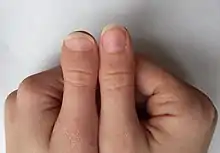Brachydaktylie Typ D
Die Brachydaktylie Typ D (auch Brachymegalodactylismus) ist die häufigste Form der Brachydaktylie, und bezeichnet eine angeborene Fehlbildung des Skelettes, die klinisch mit kurzem, dickem Daumen und breitem Nagelbett anschaulich ist. Der Grosszeh kann gleichfalls verkürzt und verdickt sein. Das Endglied (distale Phalanx) betroffener Daumen hat gewöhnlicherweise zwischen 50 und 66 Prozent der Länge nichtbetroffener Daumen. Die Erstbeschreibung dieses Types stammt aus dem Jahre 1928 durch O. Thomsen.[1]
| Klassifikation nach ICD-10 | |
|---|---|
| Q71.8 | Sonstige Reduktionsdefekte der oberen Extremität(en) |
| ICD-10 online (WHO-Version 2019) | |


Verbreitung
Die Vererbung erfolgt autosomal-dominant.[2]
Ursache
Der Erkrankung liegen zumindest teilweise Mutationen im HOXD13-Gen auf Chromosom 2 Genort q31.1 zugrunde,[3] indem erfrühtes Abrunden des Daumenendstücks (epiphysis ossis) mit diesem für Fingerentwicklung und -Wachstum (digitus manus) zentralen Gen verbunden sei.[3]
Ferner wurden Veränderungen auf dem Chromosom 7 an p15 gefunden.[4]
Literatur
- N. H. Robin, J. Hurvitz, M. L. Warman, S. Morrison: Clinical and molecular studies of brachydactyly type D. In: American journal of medical genetics. Bd. 85, Nr. 4, August 1999, S. 413–418, PMID 10398270.
- R. M. Goodman, A. Feinstein, M. Hertz: Stub thumbs in Israel revisited. In: Journal of medical genetics. Bd. 21, Nr. 6, Dezember 1984, S. 460–462, PMID 6512836, PMC 1049348 (freier Volltext).
- R. M. Stecher: The physical characteristics and heredity of short thumbs. In: Acta genetica et statistica medica. Bd. 7, Nr. 1, 1957, S. 216–222, PMID 13469150.
- L. S. Wildervanck: . In: Nederlands tijdschrift voor geneeskunde. Bd. 99, Nr. 29, Juli 1955, S. 2137–2141, PMID 13253723.
Einzelnachweise
- O. Thomsen: Hereditary growth anomaly of the thumb. In: Hereditas Bd. 10, 1928, S. 261–273.
- E. Gray, V. K. Hurt: Inheritance of brachydactyly type D. In: The Journal of heredity. Bd. 75, Nr. 4, 1984 Jul-Aug, S. 297–299, PMID 6747264.
- Brachydactyly, type D. In: Online Mendelian Inheritance in Man. (englisch).
- K. D. Williams, J. Blangero, J. Subedi, B. Jha, T. Dyer, J. L. Vandeberg, B. Towne, S. Williams-Blangero: Nonsyndromic brachydactyly type D and type E mapped to 7p15 in healthy children and adults from the Jirel ethnic group in eastern Nepal. In: American journal of human biology : the official journal of the Human Biology Council. Bd. 25, Nr. 6, 2013 Nov-Dec, S. 743–750, doi:10.1002/ajhb.22441, PMID 24022874, PMC 3968259 (freier Volltext).